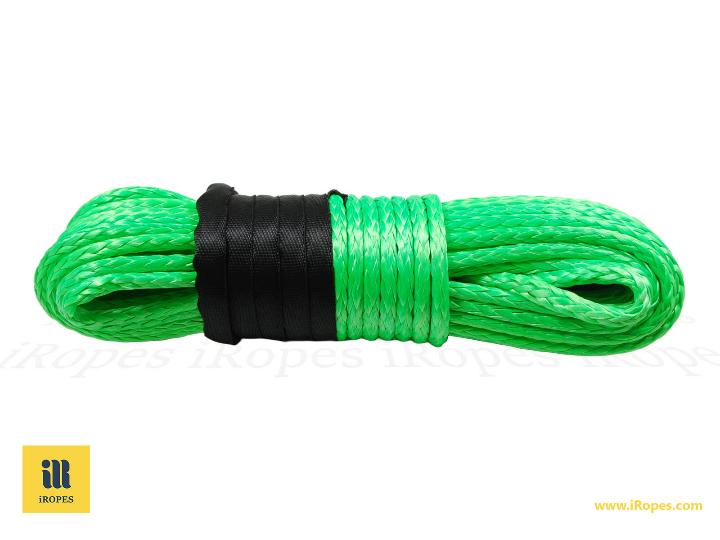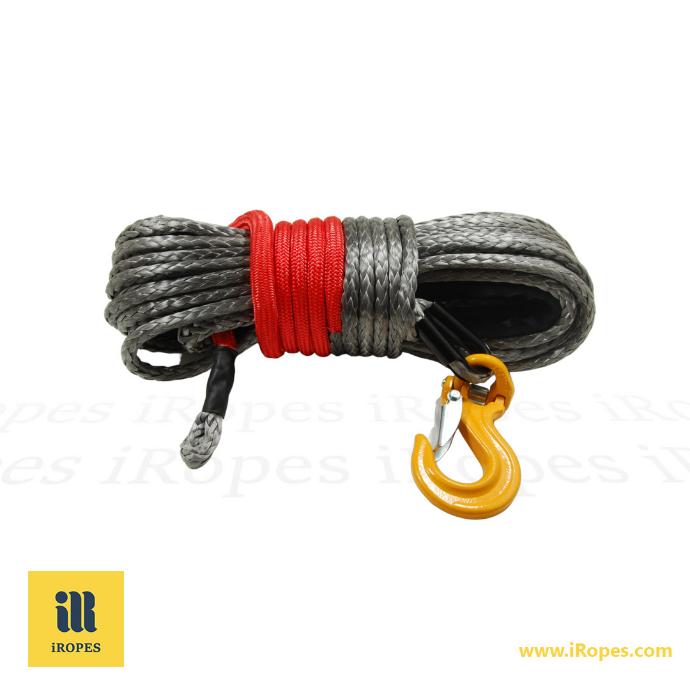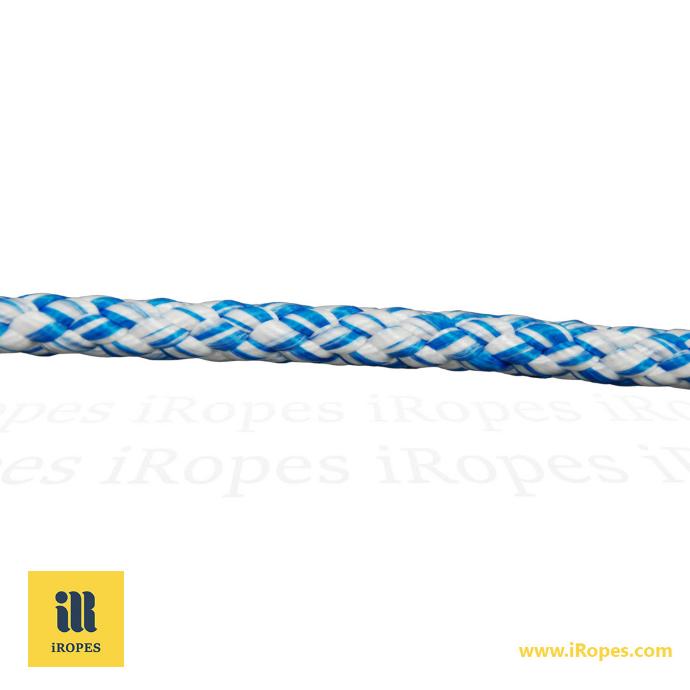Have you ever found yourself standing in front of a wall of ropes, wondering which one is best for your project? The age-old debate between synthetic and natural fiber ropes continues to perplex even the most seasoned adventurers and DIY enthusiasts. At iRopes, we've seen firsthand how this choice can make or break a project.
Picture this: a climber dangling from a cliff face, trusting their life to a slender cord. Or a sailor battling stormy seas, relying on sturdy lines to keep their vessel secure. In these moments, the difference between synthetic and natural fiber ropes becomes more than just a matter of preference—it's a critical decision.
In this comprehensive guide, we'll unravel the mysteries of natural ropes and their synthetic counterparts. We'll explore why natural fiber ropes are still relevant in today's high-tech world, and how the charm of a natural braided rope can add authenticity to your projects. From strength and durability to environmental impact and aesthetic appeal, we'll cover all the factors you need to consider when choosing the perfect rope for your needs.
Whether you're outfitting a yacht, planning an outdoor adventure, or seeking the ideal rope for your next creative endeavour, this article will equip you with the knowledge to make an informed decision. So, are you ready to discover which rope reigns supreme in the battle of synthetic vs natural? Let's dive in and find out!
Understanding Natural Ropes: Types, Properties, and Uses
When it comes to choosing the right rope for your needs, understanding natural ropes is essential. These time-tested materials have been used for centuries, and their unique properties continue to make them valuable in various applications today.
What Are Natural Ropes Made Of?
Natural ropes are crafted from organic materials that come straight from Mother Nature herself. As I run my fingers along a coarse, fibrous length of natural rope, I'm reminded of the earthy scents and textures that make these materials so distinctive. The most common natural fibers used in rope-making include:
- Cotton: Soft and lightweight, ideal for decorative purposes and gentle on the skin.
- Jute: Rough and strong, often used in crafts and gardening.
- Sisal: Durable and resistant to stretching, popular in marine applications.
- Manila: Exceptionally strong and resistant to saltwater, commonly used on ships.
- Hemp: Versatile and durable, with excellent resistance to UV damage.
Each of these fibers brings its own unique characteristics to the table, making natural ropes suitable for a wide range of uses. But did you know that the strongest natural fiber for rope-making is actually Abaca, also known as Manila hemp?
Pros and Cons of Natural Ropes vs Synthetic Ropes
Natural ropes have their strengths and weaknesses, especially when compared to their synthetic counterparts. Let's break it down:
Advantages of Natural Ropes
Biodegradable, environmentally friendly, and aesthetically pleasing
Natural ropes have a warm, traditional feel that synthetic ropes can't quite match. They're also biodegradable, making them an eco-friendly choice for environmentally conscious users. The texture and appearance of natural ropes can add a rustic charm to any setting, whether it's a nautical-themed home decor or a traditional sailing vessel.
However, natural ropes do have their limitations. They're generally more susceptible to rotting, degradation, and mildew, especially when exposed to moisture. This vulnerability to environmental factors can significantly impact their lifespan and performance in certain conditions.
In contrast, synthetic ropes offer better elongation and shock absorbency. They're often stronger for their weight and more resistant to weather and UV damage. But they lack the biodegradability and traditional aesthetic of natural ropes.
When choosing between natural and synthetic ropes, it's crucial to consider your specific needs. Are you looking for something that will blend seamlessly with nature? Or do you need a rope that can withstand harsh conditions for extended periods? The answer to these questions will guide you towards the right choice.
Remember, there's no one-size-fits-all solution when it comes to ropes. Each type has its place, and understanding the properties of natural ropes is the first step in making an informed decision. So, what's your next project? Will you be reaching for a natural rope or opting for a synthetic alternative?
Advantages of Synthetic Fiber Ropes
As I run my fingers along a sleek, synthetic rope, I'm struck by how different it feels compared to its natural counterparts. Synthetic fiber ropes have revolutionised the rope industry, offering a range of benefits that make them indispensable in many applications. Let's dive into the world of these high-performance ropes and discover why they're often the go-to choice for professionals and enthusiasts alike.
Lightweight and High Strength Properties
One of the most remarkable features of synthetic ropes is their impressive strength-to-weight ratio. I remember the first time I replaced a heavy steel cable with a synthetic rope of the same strength - the weight difference was astonishing! This characteristic makes synthetic ropes ideal for applications where every gram counts.
- Unmatched strength: Synthetic fibers like Kevlar can be up to five times stronger than steel of the same weight.
- Reduced fatigue: The lightweight nature of synthetic ropes means less physical strain during handling and installation.
- Improved efficiency: In industries like shipping and construction, lighter ropes can lead to significant fuel savings and increased payload capacity.

• Eye splices with silver tube thimble + G80 black hook, 2M black sleeve , end with
eye splice red sleeve .
• Universal drum attachment compatible with most winches.
MATERIAL: UHMWPE
CONSTRUCT: 12-Strands
ELONGATION: 4.80%
Versatility and Applications
The versatility of synthetic fiber ropes is truly remarkable. From the depths of the ocean to the heights of mountain peaks, these ropes find their place in a myriad of industries and activities. Their unique properties make them suitable for diverse applications:
- Marine industry: Synthetic ropes resist saltwater corrosion, making them perfect for mooring lines and rigging.
- Construction: Their high strength and low stretch properties are ideal for heavy lifting and securing loads.
- Sports and recreation: From rock climbing to parasailing, synthetic ropes provide the safety and performance athletes demand.
- Search and rescue: The lightweight nature and high visibility options of synthetic ropes can be life-saving in emergency situations.
But it's not just about strength and versatility. Synthetic ropes also boast impressive resistance to chemicals and UV radiation, ensuring they maintain their integrity in harsh environments. And let's not forget their ability to hold knots firmly - a crucial factor in many applications.
Have you ever considered how synthetic ropes might improve your own projects or activities? Whether you're a professional in need of high-performance equipment or a weekend warrior looking for reliable gear, synthetic fiber ropes offer advantages that are hard to ignore.
While synthetic ropes offer numerous benefits, they do have some limitations. They can be more susceptible to heat damage and may degrade under prolonged UV exposure. Always consider your specific needs and environmental conditions when choosing between synthetic and natural fiber ropes.
For a detailed comparison on the benefits and best uses of synthetic versus natural ropes, check out our article on various rope uses.
As we continue to push the boundaries of material science, the future of synthetic fiber ropes looks brighter than ever. With ongoing research and development, we can expect even stronger, more durable, and more versatile ropes in the years to come. Isn't it exciting to think about the possibilities?
Applications and Use Cases for Natural Braided Rope
As I run my fingers along the coarse fibres of a natural braided rope, I'm reminded of its timeless versatility and charm. These ropes, crafted from materials like cotton, sisal, and hemp, offer a unique blend of strength, flexibility, and aesthetic appeal that synthetic alternatives simply can't match. Let's explore the diverse applications where natural braided rope truly shines.
Industrial and Construction Uses
In the rugged world of construction and industry, natural braided rope finds its place alongside modern materials. Its strength and flexibility make it ideal for various applications:
- Lifting and hoisting: Natural fibre ropes provide excellent grip and are often used for lightweight lifting tasks.
- Load securing: The natural texture of these ropes creates friction, making them perfect for tying down cargo.
- Scaffolding: In certain heritage restoration projects, natural ropes are used to maintain authenticity.
Remember, while natural ropes have their strengths, always prioritise safety. For heavy-duty industrial applications, consult with experts to ensure you're using the right rope for the job.
If you're interested in industrial applications of synthetic ropes, take a look at our guide on high-strength rope features and applications.
Marine and Outdoor Applications
There's something undeniably nautical about natural braided rope. Its presence on boats and docks evokes a sense of maritime tradition. Here's where you'll commonly find it:
- Mooring and docking: Natural fibres provide excellent shock absorption for smaller vessels.
- Rigging: Traditional sailing ships often use natural ropes for an authentic look and feel.
- Outdoor adventures: From rugged camping trips to tree house building, natural rope adds a touch of wilderness charm.

To maintain your natural rope in outdoor settings, store it dry and avoid prolonged exposure to direct sunlight. A little care goes a long way in extending its lifespan.
An allround high-tech control line that comes in various colors and diameters.
The colored UHMWPE core also makes it easily recognizable in complex boat handling systems.
MATERIAL: Uhmwpe-Uhmpwe melange polyester
CONSTRUCT: 12 /12x1
ELONGATION: 4.8%
Home and DIY Projects
The warm, organic texture of natural braided rope makes it a favourite for home decor and creative DIY enthusiasts. Here are some inspiring ways to incorporate it into your space:
- Rustic lighting: Wrap rope around pendant lights for a coastal-inspired look.
- Garden accents: Create unique planters or trellises with natural rope elements.
- Pet accessories: Craft durable and eco-friendly toys or scratching posts for your furry friends.
Want to try a simple DIY project? Here's a quick guide to making a rope-wrapped vase:
- Clean and dry a glass vase or jar.
- Apply a thin line of strong adhesive along the bottom edge.
- Carefully wrap the natural braided rope around the vase, pressing firmly.
- Continue wrapping and gluing until you reach the desired height.
- Trim the excess rope and secure the end with glue.
The result? A unique, textured vase that brings a touch of natural warmth to any room.
When working with natural rope for decorative purposes, consider treating it with a light coating of clear sealant. This helps protect against moisture and extends its lifespan, especially in humid environments.
For more ideas on how to use different types of braided and cotton rope in home projects, check out our comprehensive guide.
From industrial strength to delicate crafts, natural braided rope proves its versatility time and time again. Its eco-friendly nature and timeless appeal make it a smart choice for those seeking alternatives to synthetic materials. So, what project will you tackle next with the enduring charm of natural braided rope?
Factors to Consider When Choosing Between Synthetic and Natural Ropes
When it comes to selecting the perfect rope for your needs, the choice between synthetic and natural fibres isn't always straightforward. As someone who's spent years working with various rope materials, I've learned that each type has its unique strengths and weaknesses. Let's dive into the key factors you should consider to make an informed decision.
Strength and Durability Comparison
The first thing most people ask me about is strength. It's true, synthetic ropes generally have the upper hand here. I remember testing a synthetic rope that was barely thicker than my thumb but could lift weights that would make a natural rope twice its size struggle. Here's a quick breakdown:
- Tensile strength: Synthetic ropes are typically 20% stronger than their natural counterparts of the same diameter.
- UV resistance: While both types can degrade in sunlight, many synthetic ropes are specially treated to withstand UV rays better.
- Moisture absorption: Natural ropes tend to swell and weaken when wet, while most synthetics remain largely unaffected.
However, don't write off natural ropes just yet. They often perform better in extreme temperatures and are more resistant to abrasion in certain conditions.

Environmental Impact and Sustainability
In today's eco-conscious world, the environmental impact of our choices matters more than ever. This is where natural ropes often shine:
- Biodegradability: Natural fibres like cotton, sisal, and hemp will decompose over time, unlike most synthetic materials.
- Production process: Natural rope manufacturing typically has a lower carbon footprint compared to synthetic rope production.
- End-of-life considerations: When a natural rope reaches the end of its useful life, it can often be composted or recycled more easily than synthetic alternatives.
But it's not all black and white. Some synthetic ropes are now made from recycled materials, and their longer lifespan means they need to be replaced less frequently. It's worth considering the full lifecycle of the rope when making your choice.
For a detailed exploration of the sustainability and uses of both rope types, read our article on steel wire cable versus fiber rope.
Application-Specific Performance
Perhaps the most crucial factor in your decision should be how you plan to use the rope. Different applications demand different properties:
- Marine use: Synthetic ropes often excel here due to their resistance to saltwater and UV rays. However, natural fibres like manila still have their place in traditional sailing.
- Climbing and mountaineering: The high strength-to-weight ratio and low stretch of synthetics make them the go-to choice for safety-critical applications.
- Industrial and construction: Both types have their uses, but synthetics are often preferred for their consistent performance and longer lifespan.
Remember, there's no one-size-fits-all solution. I've seen projects where the rustic charm of a natural rope was just as important as its functional properties.
Always prioritise safety when choosing a rope for load-bearing applications. Consult industry standards and seek expert advice if you're unsure about the best option for your specific needs.
As you weigh these factors, think about your specific requirements. Are you looking for maximum strength, eco-friendliness, or perhaps a balance of both? By considering the strength and durability, environmental impact, and application-specific performance, you'll be well-equipped to choose the right rope for your project. Remember, the best rope is the one that meets your unique needs while aligning with your values and priorities.
Choosing between synthetic and natural fiber ropes requires understanding their distinct advantages and limitations. Natural ropes, including natural braided rope, are eco-friendly and biodegradable, perfect for traditional crafts and historical reenactments. However, natural fiber ropes are generally less durable and more susceptible to moisture. In contrast, synthetic ropes offer higher strength-to-weight ratios, better weather resistance, and greater longevity, making them ideal for rigorous uses. Ultimately, the choice hinges on your specific needs, applications, and environmental considerations.
Decide on Your Ideal Rope Type Today
Fill out the form above to get personalised advice and solutions for your rope needs. Whether you prefer the traditional feel of natural ropes or the high performance of synthetic ropes, we are here to help you make the best choice.